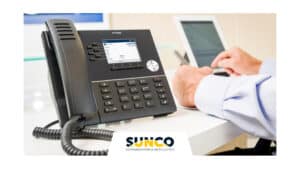The role of an IT helpdesk is crucial in ensuring smooth operations and high productivity within an organization. By implementing IT help desk best practices, you can significantly enhance efficiency and reliability.
According to industry reports, downtime costs businesses an average of $5,600 per minute. This substantial financial impact underscores the importance of effective helpdesk management to minimize disruptions.
Balaji Selvaraj, Director of IT, Sunco Communications & Installation, says, “Effective IT helpdesk management is the backbone of seamless organizational operations. Without robust helpdesk practices, companies risk significant financial losses and operational inefficiencies.”
In this blog, we will break down IT helpdesk best practices that will help you enhance service delivery, customer satisfaction, and operational efficiency.
IT Helpdesk Best Practice – Organizing Your Helpdesk Team
1. Define Clear Roles and Responsibilities
Establishing clear roles and responsibilities within the IT helpdesk team ensures that everyone knows their specific duties and can perform them efficiently.
This approach helps avoid confusion and overlaps, leading to a more organized and productive helpdesk environment. Team members can specialize in their areas of expertise, which enhances the overall quality of service.
This practice also facilitates accountability and ensures that tasks are completed promptly.
2. Provide Continuous Training and Development
Investing in continuous training and development for your IT helpdesk team is vital.
Regular training sessions keep the team updated with the latest technologies, best practices, and troubleshooting techniques. Development programs focusing on soft skills such as communication and customer service are also essential.
This not only boosts morale but also equips your team to handle diverse issues efficiently, leading to higher customer satisfaction.
3. Foster a Collaborative Team Environment
Encouraging collaboration within the IT helpdesk team can lead to better problem-solving and knowledge sharing.
Implementing team-building activities and fostering a culture of open communication helps build trust and cooperation among team members. A collaborative approach ensures that complex issues are addressed efficiently and that the team can support each other in challenging situations.
This environment also promotes continuous learning and improvement.
| More articles you might like: What Are The Risks & Benefits of IT Outsourcing Services? 7 Cybersecurity Best Practices That Enhance Fraud Prevention Why Use Managed IT Services? |
Optimizing Helpdesk Processes
1. Implement a Ticketing System
A robust ticketing system is fundamental to managing and tracking helpdesk requests.
It helps prioritize tasks, ensuring timely resolution, and maintaining a record of all issues and their solutions. This system also provides valuable insights through data analytics, helping to identify recurring problems and areas for improvement.
In fact, 86% of service teams have observed a notable increase in productivity by utilizing a structured approach to helpdesk implementation. The organized approach facilitates efficient workflow management and enhances the overall effectiveness of your organization.
2. Establish Standard Operating Procedures (SOPs)
Creating and adhering to Standard Operating Procedures (SOPs) ensures consistency and efficiency for handling helpdesk requests.
SOPs provide clear guidelines on addressing common issues, escalating complex problems, and documenting solutions. This standardized approach reduces response times and enhances the overall quality of service provided by the helpdesk team.
SOPs also help new team members acclimate quickly, maintaining service quality.
3. Monitor and Measure Performance
Regularly monitoring and measuring the performance of your IT helpdesk is crucial for continuous improvement.
Key performance indicators (KPIs) such as response time, resolution time, and customer satisfaction should be tracked. Analyzing these metrics helps in identifying strengths and weaknesses, allowing for targeted improvements in helpdesk processes.
This proactive approach ensures that the helpdesk continually evolves to meet user needs effectively.
IT Helpdesk Best Practices – Leveraging Technology
1. Utilize Remote Support Tools
Remote support tools enable IT helpdesk teams to resolve issues quickly and efficiently without on-site visits.
These tools allow technicians to access and troubleshoot user devices remotely, saving time and reducing downtime. Incorporating remote support capabilities enhances the helpdesk’s ability to provide timely assistance and improves overall productivity.
This IT helpdesk best practice is essential for maintaining high service standards in a remote working environment.
2. Implement Knowledge Management Systems
A comprehensive knowledge management system is an invaluable resource for both helpdesk technicians and end-users.
It provides a centralized repository of solutions, best practices, and troubleshooting guides that can be easily accessed. This system empowers helpdesk staff to resolve issues faster and allows users to find answers to common problems independently.
With knowledge management systems being able to reduce information search times by 30%, this not only improves efficiency but also enhances user satisfaction by providing quick solutions.
Transform Your IT Helpdesk Today
Discover how our expert services can help you implement IT helpdesk best practice
3. Leverage Automation and AI
Automation and artificial intelligence (AI) can significantly enhance the efficiency of IT helpdesk operations.
Automated workflows streamline repetitive tasks, while AI-powered chatbots handle basic inquiries and provide immediate assistance. These technologies reduce the workload on human agents, allowing them to focus on more complex issues and improving the overall speed and quality of helpdesk support.
Leveraging these technologies is crucial for modernizing helpdesk operations and meeting user expectations.
In fact, 92% of large organizations opt to outsource their helpdesk services for improved efficiency and expertise, says CloudSecureTech, demonstrating the growing trend among large organizations to rely on specialized external providers.
To provide a clear overview, here’s a comparison of key IT helpdesk best practices and their benefits:
Table: Comparison of IT Helpdesk Best Practices
| Best Practice | Description | Benefit |
| Define Roles and Responsibilities | Clear duties and tasks for team members | Improved efficiency and accountability |
| Continuous Training | Regular updates and skill development for staff | Enhanced service quality and team morale |
| Collaborative Environment | Open communication and teamwork | Better problem-solving and knowledge sharing |
| Ticketing System | Manage and track helpdesk requests | Increased customer satisfaction |
| Standard Operating Procedures | Consistent guidelines for handling issues | Reduced response times and operational performance |
| Performance Monitoring | Track KPIs and analyze metrics | Continuous improvement |
Adopting these strategies will not only streamline your helpdesk processes but also enhance overall customer satisfaction and business performance.
Partner with Sunco for Superior IT Helpdesk Solutions
Our expert team is dedicated to optimizing your IT helpdesk operations, ensuring minimal downtime and maximum productivity. With industry-leading best practices and cutting-edge technology, we provide comprehensive support tailored to your business needs.
Reach out to us and elevate your IT service delivery today.






